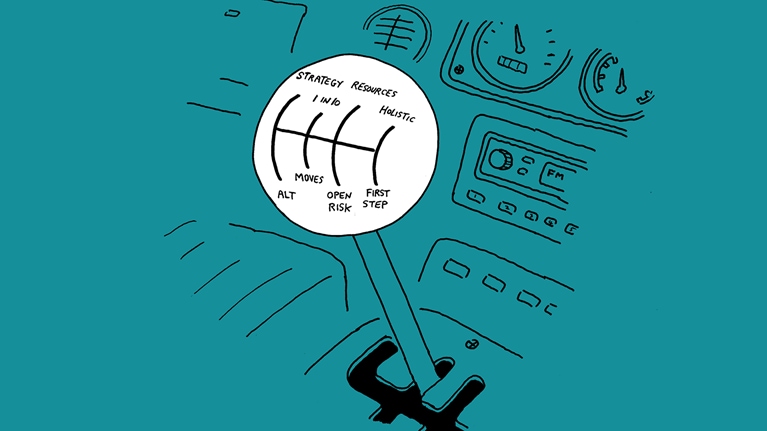In this episode of the Inside the Strategy Room podcast, two McKinsey partners share their insights on preparing organizations for macroeconomic crises. In their conversation with Strategy & Corporate Finance communications director Sean Brown, they also explain why the next downturn may be very different from earlier ones. This is an edited transcript. You can listen to the episode on Apple Podcasts, Spotify, or Google Podcasts.
Podcast transcript
Sean Brown: Welcome to Inside the Strategy Room. In this episode we’re talking to two of our experts about their new research on corporate resilience and what differentiates companies that emerge from economic downturns stronger than they were going in. With me is Kevin Laczkowski, a senior partner in our Chicago office who leads our corporate strategy service work, and Mihir Mysore, who is a partner in our Houston office and a leader of our work in crisis response globally. Kevin and Mihir, welcome.
Kevin, let me start with you. Why has resilience become a topic of so much focus for clients these days?
Kevin Laczkowski: The United States has seen expansionary periods that last for roughly eight to ten years at any point in time over the last 50 years. We are in about year ten of economic expansion, which leads to questions about its sustainability. Unfortunately, we cannot predict when the next downturn will come. The running joke is that experts predicted seven of the last three economic downturns, and we doubt the success rate will improve next time.
We looked at companies that navigated macroeconomic crises in ways that set them apart from their peers. We found those that prepared early emerged much stronger coming out of the downturn, and the advantage they gained lasted for a long period (Exhibit 1).

Sean Brown: Can you briefly walk us through how you arrived at your conclusions?
Kevin Laczkowski: We turned to data. We looked at 1,000 publicly traded companies in North America and Europe with more than $1 billion in revenue. We excluded financial institutions because total returns to shareholders (TRS)—the metric we used—looked different there, but we ran a similar analysis for them and the key messages still held. We then analyzed how those companies performed relative to their industries. For the companies that we found had outperformed, we dove deeper to understand what they did differently—and, almost more importantly, when they did it.
We then developed what we call the resilience power curve, which shows the total returns to shareholders of all the companies in the sample, ordered from lowest to highest for the period of 2007 to 2011. The average TRS during that time was zero, and 45 percent of the companies had negative returns. But the top quintile actually did quite well. Their average annual TRS was 9 percent, and the median in that group was almost 20 percent—pretty good performance in a really tough macroeconomic environment.
We then looked at how companies performed relative to their sectors. For example, we analyzed consumer packaged goods (CPG) companies and found a group that delivered, on average, 10 percent TRS annually compared to the sector average of 4 percent. We call these companies the resilients.
To put a little color around that, if you had a large CPG company with a $100 billion market capitalization in 2007, at the end of 2011 the value creation difference between that company and the average would be $30 billion. If you extend that out over a ten-year period, that excess value creation is $130 billion—a big, big difference. And the resilients’ outperformance extends for a long period of time: in those ten years, they outperformed the nonresilients by 150 percent. Also, they delivered essentially double the returns of the S&P 500. As a matter of fact, 70 percent of the resilient companies coming out of the financial crisis are still in the top quintile today, so the advantage is quite sticky.
Sean Brown: What did these resilient companies do differently than their peers?
Mihir Mysore: The first thing we found is that the resilients outperformed on earnings throughout, almost quarter by quarter. And they drove recovery much faster than others (Exhibit 2). On the revenue side, we wondered whether resilients’ outperformance was simply a function of their portfolio. If, for example, you happen to cater to a lower-income demographic in the CPG sector, you might see a bump in your business during a recession. We saw that there was some portfolio effect but, by and large, the biggest effect was around EBITDA [earnings before interest, taxes, depreciation, and amortization]. The resilients were able to grow EBITDA consistently, no matter what the outside conditions were, without interruption.

Compare that to the nonresilients. By the time the depth of the recession came around, resilients had an astounding 25-point higher EBITDA than nonresilients. On the revenue side, resilients and nonresilients marched hand in hand until about 2009, but there is a noticeable difference by the time the trough hits, and a divergence really kicks in during the recovery period.
The key takeaway for us was that the resilients are doing something different when it comes to EBITDA margins. To see what was driving this margin growth, we looked at changes in operating costs, and what we found was that during the downturn portion, meaning 2007 to 2009, resilients cut their operating costs by half a dollar for every dollar of revenue change, while nonresilients increased their operating costs in the same period. During the recovery, resilients were able to build on the momentum they had secured and cut costs even faster for every unit of revenue change. It wasn’t that they timed the cycle. Once the recession became clear, resilients were simply able to move faster, cut costs, and increase earnings.
Sean Brown: One of your more intriguing findings is that the resilients were much more aggressive dealmakers, in selling off business but also in acquiring. Can you tell us more about that?
Mihir Mysore: Resilients had noticeably stronger divestitures, in particular during the down cycle. They also acquired far more than nonresilients did during the recovery period. Of all the deals the resilients did, a quarter focused on divesting parts of their businesses versus about 18 percent for nonresilients. Compare that with acquisitions during the recovery: a whopping 96 percent of the total deal value for resilients was in acquisitions.
Subscribe to the Inside the Strategy Room podcast
Sean Brown: It sounds like resilient companies were able to free up resources to take advantage of acquisition opportunities and otherwise gave themselves the ability to react to changing circumstances. Is that right?
Mihir Mysore: The resilients were able to create optionality. In our analysis, this shows up as financial deleveraging and optimizing the balance sheet, but the focus was really on creating both operational and financial flexibility to enable them to get through the recession. During the downturn, resilients cut about $1.20 for every dollar of capital while the nonresilients ended up growing their debt dramatically. During the recovery, this flipped and resilients focused on increasing their leverage ratio while nonresilients continued to try to catch up and reduce their debt to capital. Again, the resilients were able to move faster.
Sean Brown: Do you think the next downturn, whenever it may come, will differ significantly from the previous one?
Mihir Mysore: Our analysis focused on the last recession, and while we think those lessons still apply, we believe there will be a difference (Exhibit 3). First, most sectors are experiencing various forms of digital disruption, either as customers demand a frictionless mobile experience or as businesses discover new ways to drive efficiency through advanced analytics and digital techniques. Coming into the last recession, there were only two tech-enabled companies that absolutely dominated their sectors. Now, seven out of ten sector-dominant companies are digital natives. That fundamentally shifts the landscape because some of these digital natives have a preexisting cost advantage.

Also, this disruption isn’t slowing down. Back in 2013, right after the last downturn, about 39 start-ups were deemed unicorns. That figure is now ten times bigger.
Sean Brown: Do any other differences stand out to you between today and a decade ago that may make the next downturn distinctive?
Resilients had noticeably stronger divestitures, in particular during the down cycle. They also acquired far more than nonresilients did during the recovery period.
Mihir Mysore: Many companies don’t believe they have as much fat to trim as they did going into the last recession. We did a survey at the Davos meeting as well as at a similar forum in New York a few months ago, asking the assembled CEOs whether there were significant opportunities to take costs out of their core businesses in the case of a downturn. And the answer overwhelmingly was no. Financial institutions are a good example. The pressure to reduce cost has felt like part of their daily business vocabulary for the past six or seven years. Add the presence of activist investors and other sources of disruption and many companies feel they are pretty far along this journey already.
Sean Brown: What about the current global trade and sociopolitical shifts? Do you think these will affect how a macroeconomic event may play out?
Mihir Mysore: Yes. The sociopolitical context presents challenges, requiring resilience playbooks to become a lot more sophisticated. The concern that companies are funneling wealth to an ever-smaller group of extremely rich individuals is real. There is a debate happening across the world around income and socioeconomic inequality, which in turn means that any attempt to cut costs is met with activism and pushback against the brand. Companies considering big cost actions that might, for example, affect frontline jobs have to think through these second-order effects much more. If you shut down a plant, you should expect negative regulatory, government, and consumer impact and decide whether it’s still worth doing.
Sean Brown: So, Kevin, what can companies do today to prepare for a potential macroeconomic event?
Kevin Laczkowski: The resilience playbook that we see emerging has two primary elements: accelerated decision-making and resilience interventions. It’s not a laundry list of 1,000 things you need to think about but six actions that encapsulate a lot of the lessons we learned from previous macroeconomic events while taking into consideration changes happening now.
The first is to create what we call a resilience nerve center. Think of this as the body within the organization that brings order to the chaos. It would leverage lessons from crisis management and risk practice around stress testing the balance sheet, understanding exposure angles, and the timing of different interventions. The second is organization simplification. This ranges from trimming organizational layers all the way to zero-based budgeting, with the intent of not only reducing cost but also increasing intervention speed. The third is alignment. The operating model of the top team needs to change to increase the metabolic rate of decision making. The leaders not only have to move faster but understand the second- and third-order implications of different actions. As Mihir discussed, the environment has changed and closing a plant or offshoring has different implications now than it had ten years ago.
Would you like to learn more about our Strategy & Corporate Finance Practice?
These are the three key elements of accelerated decisions. As for resilience interventions, the first is to unlock the balance sheet. As we saw in the last downturn, the emphasis on balance sheet management relative to the P&L swings tremendously. We expect that lesson will apply to the next macroeconomic event, where cash becomes king. Two other critical elements to this are divesting underperforming assets to increase financial flexibility and shoring up the balance sheet so you are ready with an M&A target list coming out of a downturn.
A sharp digital program is the second intervention lever. Every company in the world has a ton of pilots going on. According to our Digital Practice, more than 70 percent of companies are stuck in pilot purgatory, meaning they have a lot of little digital investments all over the organization. You have to rationalize those pilots and double down on the few digital programs that have scaled and can meaningfully move the needle on value creation. And the last element is through-cycle interventions. These are primarily operational and revenue-based, but the twist is that they need to incorporate a big element of flexibility. If you sole-source your materials, you are at risk during a macroeconomic event because your suppliers might not make it through, so you need to have plans in place to intervene.
Sean Brown: How do you go about deciding which levers to implement when?
Mihir Mysore: You need to define how to move from business as usual to saying, “OK, here is where we see the scenario going and this is what it means for the company.” That is the how and will probably take some time to get right. But then you combine that with the what. That is, fundamentally, about saying, “Do we have a perspective on the potential scenarios and have we done some stress tests so we know the likely impact on us?” That is incredibly important. The level of detail matters—not just looking at the macroeconomic effects and overall demand trends but thinking about how those trends will play out in your sector in a given scenario, and how they will play out specifically in your company.
Once you pick the scenario, you need to determine the momentum case for your P&L and balance sheet. What is the opportunity with each of the six levers for the overall balance sheet and the P&L? Then you focus on those that will be the most impactful. What initiatives should you prioritize in the scenario you are analyzing? That helps you arrive at the high-level road map. Ultimately, you want to get to one planning scenario that becomes the basis for the organization to act. There is a lot of judgment involved in deciding what that planning scenario looks like, but we have seen far too many organizations struggle with multiple scenarios because they don’t want to make a choice and end up doing nothing.
Once you decide on the biggest investments you want to go after, focus on assembling teams for each. Make sure these are outcome-based themes on which you can move faster than usual, that have a higher level of decision authority and are more cross functional, and so on. And then during weekly or biweekly decision meetings the leadership teams should break down any barriers that each of these teams may be facing. You want to move from what might seem like external chaos to having a certain way of dealing with that chaos inside the organization, and this resilience team would act like a buffer.
Sean Brown: Kevin, what do you see as the most important first steps in developing such a resilience playbook?
Kevin Laczkowski: You need alignment across the top team. This must be driven from the top down. It has to be a senior management team priority, or it doesn’t work. The second step is setting up the resilience nerve center and staffing it with high performers who can take macroeconomic scenarios, bring them down to the company level, understand how to stress test, and know what interventions and diagnostics the organization needs.
A resilience playbook needs alignment across the top team. It has to be a senior management priority, or it doesn’t work.
You also need to get those initial models built up in order to understand the biggest gaps under the planning scenario, so you know the few critical things you need to do. Finally, developing the governance cadence and rhythm in your management team is important in order to figure out how you will make decisions under uncertainty.
Sean Brown: Would you recommend running a kind of fire drill to see how the resilience leadership team would handle a crisis?
Mihir Mysore: I think the idea of a fire drill is important. Leadership teams need to develop muscle memory on how to behave during major uncertainty, especially at times when the rulebook is breaking down. In an extreme recession or disruption, management teams frequently find that the pattern recognition they developed doesn’t work anymore.
Sean Brown: Any final thoughts you would like to share?
Kevin Laczkowski: This quote has been attributed to various people, but it’s fitting here. “Every morning in Africa, a gazelle wakes up. It knows it must move faster than the lion or it will not survive. Every morning a lion wakes up and it knows it must move faster than the slowest gazelle or it will starve. It doesn’t matter if you are the lion or the gazelle, when the sun comes up, you’d better be moving.” We offer that quote as a frame: you have to get ahead in planning for macroeconomic events because those who move early are the ones who tend to thrive.
Sean Brown: Thank you for joining us.


